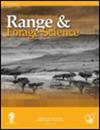牧草竞争和土壤水分对上卡鲁东部卡鲁灌木生长和物候的影响
IF 1.9
4区 环境科学与生态学
Q3 ECOLOGY
引用次数: 0
摘要
Nama-Karoo的降雨是零星的,植物获取和利用可用土壤水分的能力将决定其在该系统中持续存在和成功招募的能力。当东部卡鲁的夏季降雨增加时,草的增加以牺牲灌木冠层的覆盖为代价。这可能会促使灌木地向草原过渡。根生态位分离假说和演替假说不能充分解释草-灌木竞争对东部卡鲁灌木生长和物候的影响。在一项实验中,我们测量了2017/2018年降雨季节无草(修剪处理)和有草(对照处理)下灌木的生长和物候。在此期间,割草改变了草的种类组成,但对灌木没有好处。我们没有发现禾草对灌木的竞争效应。然而,灌木冠层盖度对土壤湿度表现出强烈的线性响应,对温度也表现出强烈的线性响应。同样,土壤湿度和温度对茎生长和灌木物候也很重要。灌木生长模式和物候对夏季和冬季降雨的响应为土地管理者优化生产提供了重要的见解,同时使物候过程能够进行招募。本文章由计算机程序翻译,如有差异,请以英文原文为准。
The influence of grass competition and soil moisture on the growth and phenology of Karoo shrubs in the Eastern Upper Karoo
Rainfall in the Nama-Karoo is sporadic and a plant’s ability to access and utilise available soil moisture will determine its ability to persist in the system and to successfully recruit. When summer rainfall in the Eastern Karoo increases, grassiness increases at the expense of shrub canopy cover. This may drive a transition from shrubland toward grassland. The effect of grass–shrub competition on shrub growth and phenology in the Eastern Karoo is not adequately explained by the root–niche separation hypothesis or the succession hypothesis. In an experiment, we measured shrub growth and phenology in the absence (clipping treatment) and presence (control treatment) of grass over the 2017/2018 rainfall season. Grass clipping changed grass species composition over this period, but grass clipping did not benefit shrubs. We found no competitive effect of grasses on shrubs. However, shrub canopy cover showed a strong linear response to soil moisture, as did canopy cover to temperature. Similarly, soil moisture and temperature were important for stem growth and shrub phenology. Patterns of shrub growth and phenology in response to summer and winter rainfall provide important insight for land managers for optimising production while enabling phenological processes that allow recruitment to take place.
求助全文
通过发布文献求助,成功后即可免费获取论文全文。
去求助
来源期刊

African Journal of Range & Forage Science
ECOLOGY-ENVIRONMENTAL SCIENCES
CiteScore
4.00
自引率
14.30%
发文量
35
审稿时长
>12 weeks
期刊介绍:
The African Journal of Range & Forage Science is the leading rangeland and pastoral journal in Africa. The Journal is dedicated to publishing quality original material that advances rangeland ecology and pasture management. The journal aims to publish research of international importance from any region, but as an African journal, we are particularly interested in research from Africa and relevant to the continent. The Journal promotes both science and its application and authors are encouraged to explicitly identify the practical implications of their work. Peer-reviewed research papers and research notes deal primarily with all aspects of rangeland and pasture ecology and management, including the ecophysiology and biogeochemistry of rangelands and pastures, terrestrial plant–herbivore interactions (both domestic and wild), rangeland assessment and monitoring, effects of climate change on rangelands, rangeland and pasture management, rangeland rehabilitation, ecosystem services in support of production, conservation and biodiversity goals, and the identification and development of intensive and semi-intensive pasture and forage resources to meet livestock production needs. Articles highlighting transdisciplinary linkages among biophysical and social sciences that support management, policy and societal values are particularly encouraged. The Journal includes relevant book reviews and invited perspectives that contribute to the development of range and forage science. Letters to the editor that debate issues raised in the Journal are acceptable. The African Journal of Range & Forage Science is the official journal of the Grassland Society of Southern Africa.
 求助内容:
求助内容: 应助结果提醒方式:
应助结果提醒方式:


